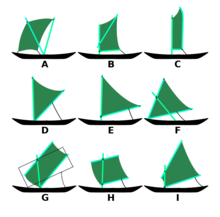Talk:Lakana
| This article was nominated for deletion on 12 September 2024. The result of the discussion was redirect. |
| This redirect does not require a rating on Wikipedia's content assessment scale. It is of interest to the following WikiProjects: | ||||||||||||||||||||||||
| ||||||||||||||||||||||||
Complete work of fiction
[edit]This article appears to be a complete work of fiction. The word lakana in Malagasy is, as far as I can tell, simply a word for a canoe. (Note that the French term pirogue is apparently used synonymously with lakana.) It is not specifically an outrigger canoe, nor does it necessarily or traditionally have a sailing rig and that sailing rig is not limited to any particular type. Please would editors with a good understanding of Malagasy and/or its traditional sailing craft please take a look at this article (as it currently stands) and make some comment on whether it has any merit.
I find it disturbing that while there is the potential for an interesting article on the sailing craft of Madagascar, this is the best that Wikipedia has to offer. One problem is sources. For instance Hornell, James (1920). "67. The Common Origin of the Outrigger Canoes of Madagascar and East Africa". Man. 20: 134–139. doi:10.2307/2839454. Retrieved 5 September 2024. is an old source. James Hornell is seen as an authority on the ethnography of sailing craft, but his working methods were limited to, in the case of this paper, correspondence with local colonial representatives on details of craft. There is a later paper based on more material gathered in 1926 on a personal visit to Madagascar by Hornell: Hornell, James (January 1944). "THE OUTRIGGER CANOES OF MADAGASCAR, EAST AFRICA AND THE COMORO ISLANDS". The Mariner's Mirror. 30 (1): 3–18. doi:10.1080/00253359.1944.10658860., but many working today in this field assert that Hornell never actually saw any of the craft he describes in the paper under sail.
Any comments on this would be very welcome. ThoughtIdRetired TIR 20:53, 5 September 2024 (UTC)
- Note that the 1920 source given above includes:
"Lakana, a boat or canoe; lakam-piara, an outrigger canoe " avec banc" lakem-jilo, an outrigger canoe "ayant mat et vergue a la mode des boutres"; fanarina, outrigger float (litt. "that which maintains the equilibrium," from the root arima, balance or "aplomb "), or fangarahanit (litt. " that which is always covered," i.e., by the water); varona or varonandakana, the out-rigger booms ; tatika, the connecting stanchion ; f Irana, prow; five paddles ; lopondra, punting pole ; havitra, boat hook (from Malay kawit, fide G-randidier); dima, wooden bailer; lay, sail."
Google translate tells us that "ayant mat et vergue a la mode des boutres" means "having mast and yard in the fashion of dhows", so does this mean that lakem-jilo is a craft with a lateen rig? The Vezo appear to make extensive use of a spritsail rig, with some local variations – but again the problem is sources. No RS seems to have noticed this. Without sources, no article. ThoughtIdRetired TIR 09:29, 6 September 2024 (UTC)- I've looked at the supplied sources and they don't seem to support anything. (I'm only replying here because you asked me as a recent editor for my views. However, I know almost nothing about Madagascar or boats.) My feeling is it should be put up for deletion to force a debate. But you could try canvassing on the French Wikipedia (there's Lakana article there, and I suspect one article is derived from the other), or outside Wikipedia such as r/Madagascar on Reddit, or boat forums or something.--A bit iffy (talk) 18:40, 6 September 2024 (UTC)
Problem picture caption (reverted)
[edit]
I have reverted this edit[1] as the caption A lakana with a traditional sail set between two sprits
is incorrect. The boat shown has the type of rig labelled "B" in Doran's categorisation of traditional Austronesian rigs. The description is for the rig labelled "A".

In order to explain this, we need to accept that Commons does not have the same verifiability as Wikipedia. So we cannot rely on Commons for a correct caption. (Though there is not much of a problem with the one in this case.) So, where does the idea come from that this sail is "set between two sprits"? This interpretation appears to be OR as there is no RS that interprets the picture for us. Hornell, who is seen as the main authority on the ethnography of rigs, did not mention the "B" rig in Madagascar, but does describe it in the Comoros. He does describe the "mastless" rig with two sprits in Madagascar, which is what we see in the picture swapped back to in the reversion.
An informed editor might be aware that there are plenty of videos (e.g.[2]) of the "B" rig in Madagascar on the internet. Watching these, it is clear that (a) the reverted picture is this type of rig and (b) it is a common spritsail, with effective performance to windward and an operation that would be recognisable to any sailor who has used a spritsail. However, putting that in an article is OR. The fundamental problem of this article is that interpreting the rigs in photos is OR – and there is a huge lack of sources that can fill this gap. ThoughtIdRetired TIR 17:59, 25 September 2024 (UTC)



